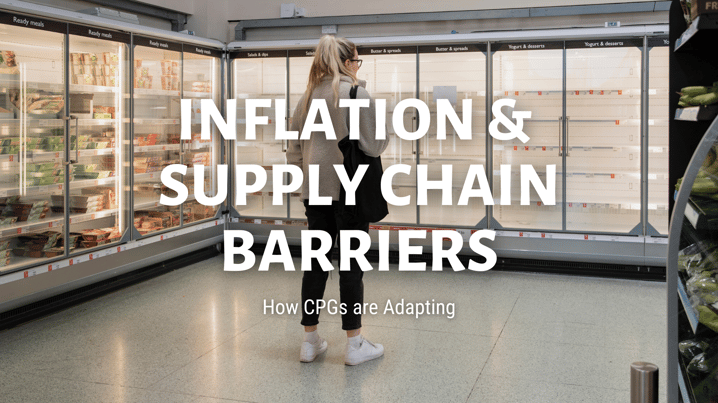Inflation and Supply Chain Barriers: How CPGs are Adapting

The summer of 2022 finds us in the midst of the worst inflation that the country has seen in a generation.
Driven by ever-worsening effects of climate change, lingering fallout from the peak of the ongoing pandemic, and the Russian war in Ukraine, the prices of necessities like fuel and ingredients are sky-high, which drives up costs for businesses and consumers alike.
A recent survey from the ingredient sourcing platform, TraceGains, collected responses from over 300 food and beverage companies to understand how these conditions have affected higher decision-making and the ripple effect of those choices on CPG production.
TraceGain’s CEO, Gary Nowacki, had this to say about the purpose of the survey:
"As consumers, we feel the pain of supply chain issues each time we walk out of a grocery store. This survey sheds light on the problem directly from a CPG brand's perspective, and lets other food and beverage companies know they're not alone in this fight. Forward-thinking brands have used this unfortunate time as a wake-up call to modernize antiquated operations and those who already have are much better positioned to mitigate disruptions with as little impact as possible."
Inflationary conditions have created a need for innovation on a massive scale, and while we may be starting to see signs of a reprieve, the survey results indicate that almost 90% of surveyed Consumer Packaged Goods companies (CPGs) have already taken steps to adapt to the fraught economic environment.

How are CPGs responding to the higher cost of ingredients?
CPG companies, of course, need the basic ingredients that make up the recipes of their products. With these ingredients costing more, businesses either have to make changes or accept reductions in their bottom line.
To keep your cost of goods sold low, you can either change your recipe or simply make less of it. You must also allocate your resources wisely.
Recipe modifications, discontinuations, and ‘shrinkflation’
Expensive commodities raise the cost of production. To stay profitable, CPGs are having to alter their formulas, discontinue products, or charge more for them.
According to the TraceGains report, 37% of CPGs have modified 20 or more of the recipes in their lineup. An additional 25% changed between six to 20 products.
Close to 50% of the respondents reported having to discontinue items, and 46% admitted to being unable to keep up with purchasing demand. 65% said they had no choice but to raise prices in recent years.
Some companies have adopted a different tactic, dubbed “shrinkflation.” Rather than change recipes or increase prices, these CPGs simply reduce the amount of product in each package while keeping the price the same—a move that isn’t always so obvious to casual shoppers.
The innovation dichotomy
Like altering formulas or discontinuing products, CPGs are faced with the decision of either expanding or contracting resources spent on innovation. The TraceGains report reveals a dichotomy in how businesses have handled the decision.
Of those surveyed, more than a third reported cutbacks on research and development, while an almost equal number have increased their efforts in new products and innovation.
It may be years before we understand which strategies win out, but we know that CPGs are taking some inflation-coping lessons with them into the future.
Looking ahead
Plagued with supply chain issues, CPGs are uneager to repeat the headache of managing resource scarcity.
There are several ways to prepare for barriers in the supply chain, but the majority of surveyed companies told TraceGains that their focus would be on diversifying their suppliers, with 69% of survey respondents reporting plans to grow their supplier networks within the next two years.
Again, expansion isn’t the only valid strategy—25% of companies intend to pull back, reshoring the base of their supply chain to bring it closer to home. 41% will altogether discontinue products that rely on unstable suppliers.
How DSD Food Distributors Can Shorten the Supply Chain
When production is low and prices are high, you can’t afford to have empty shelves that could take days for a central distributor to restock.
Buffalo Market offers Direct to Store Delivery (DSD) food distribution, meaning we’ll deliver products from the manufacturer’s facility directly to the retailer. This guards against out-of-stocks, saves labor costs, and ensures a more consistent shopping experience for customers.
If you’d like to learn more about how the DSD food distributors at Buffalo Market can help insulate your business from supply chain issues, reach out to our team today!




